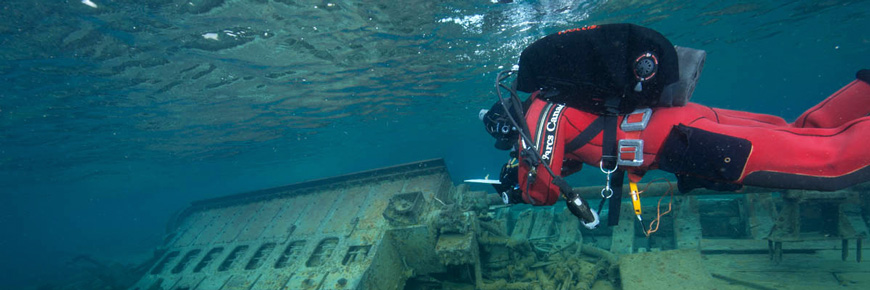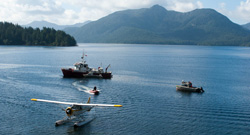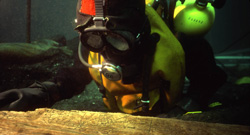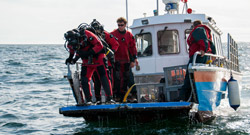
Underwater archaeology
Underwater archaeology deals with archaeological sites found below the surface of oceans, rivers, and lakes and on the foreshore. In addition to shipwrecks, underwater archaeologists study submerged aboriginal sites such as fish weirs and middens; remains of historic structures such as wharves, canal locks, and marine railways; sunken aircraft; and other submerged cultural heritage resources.
Underwater archaeology shares the same methodology and principles as archaeology carried out on land sites. All archaeology involves the careful study of artefacts, structures and features to reconstruct and explain the lives of people in the past. However, because it is carried out in a more challenging environment, underwater archaeological fieldwork is more complex than land archaeology.
Specialized techniques and equipment are required to work productively underwater. Staying warm during long dives is a constant concern, so underwater archaeologists often use masks that cover their entire faces, dry suits worn over layers of warm clothing, or in cases where the water is extremely cold, such as the excavation in Red Bay (Labrador), wet suits supplied with a flow of hot water. Underwater communication systems are used to talk to people on the surface or to other divers. Removing sediments covering underwater sites requires the controlled use of specially designed equipment such as suction airlifts and small dredges. Recording information underwater presents its own challenges. Special underwater paper is used for notes and drawings, while photo and video cameras are placed in waterproof housings.
Underwater archaeological fieldwork includes remote-sensing surveys using geophysical techniques, diving surveys to locate and map sites, site monitoring, and excavation. The success of an underwater archaeological project rests on accurate documentation of all aspects of the process. Meticulous mapping and recording are particularly essential when excavation is required, as artefacts and other physical evidence are permanently removed from their original contexts. Archaeologists aim to be able to reconstruct the entire site from the records they generate during fieldwork.
Underwater archeology with Marc-André Bernier
Transcript
Parks Canada logo animation
[Marc-André Bernier on a ship in open waters]
Hi I’m Marc-André Bernier, I’m the manager of underwater archaeology at Parks Canada.
So archaeology, the work of an archaeologist is basically to study history
[Parks Canada divers exploring a shipwreck]
and study history through the remains left by man in the past. So we’re looking at history through objects. Underwater archaeology is the same thing, it’s archaeology, but it’s studying sites and objects that are now underwater. These things could be pre-contact or prehistoric sites. It could be also habitation sites, dam sites,
[Divers getting ready to go into the water]
but there’s a lot of shipwrecks because we have three oceans,
the Great Lakes, the St-Lawrence River and so many other rivers. That’s why ships and navigation is such a part of our country’s history.
What’s really incredible and quite amazing here at Fathom Five National Marine Park is the assemblage of the shipwrecks that we have here. We have a really nice collection of wrecks from the late 19th century to the beginning of the 20th century and even a little more.
During that period where you can see sail transitioning, ships transitioning from sail to steam and you can see at times the conflict between the sail trying to compete with steam. And that you can see, you can have a very wide angle on this navigation history here at the park. You can dive on shipwrecks that are sailboats, schooners and see the proud bows still upright.
You can also see steamships with the powerful boilers and engines that tell us about that transition into a new history of navigation.
So what’s really important for us at Parks Canada here at Fathom Five National Marine Park is to obviously preserve the shipwrecks and protect them for generations to come, but also and most importantly to give access to people to these sites so they can enjoy their history, understand it and touch this rich maritime history that is so important to the history and story of our country.
Parks Canada signature
© Her Majesty the Queen in Right of Canada, Represented by Parks Canada, 2017.
Canada wordmark
The history of Canada in underwater photos:
Underwater Archaeology at Parks Canada:
- Date modified :



